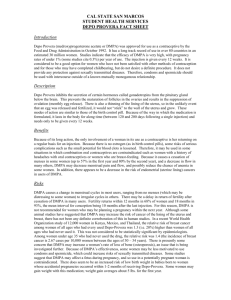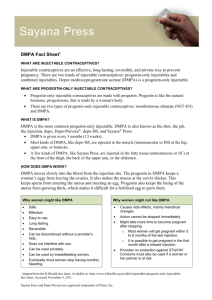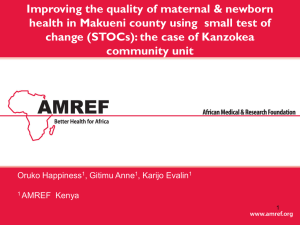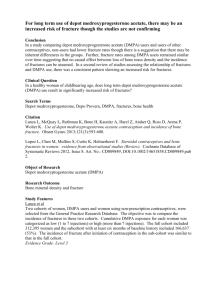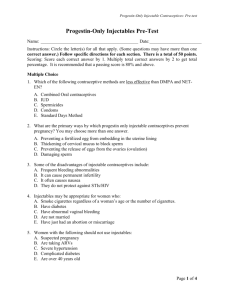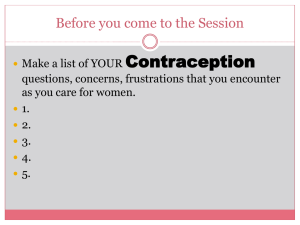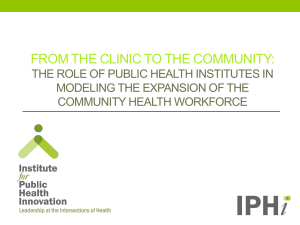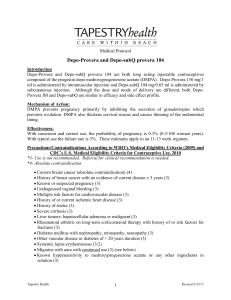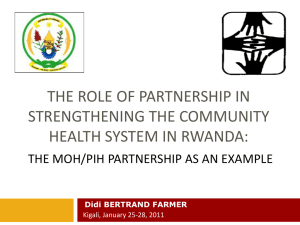Community Based Health Care Role of CHW CHW
advertisement
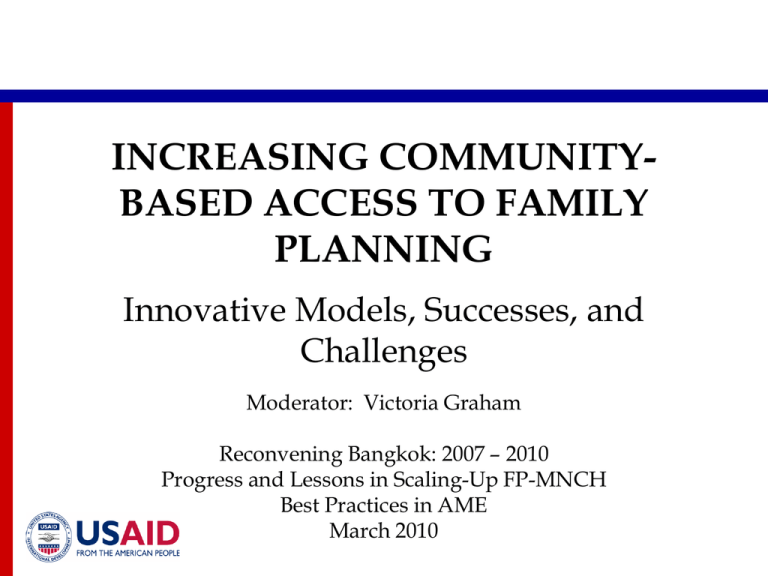
INCREASING COMMUNITYBASED ACCESS TO FAMILY PLANNING Innovative Models, Successes, and Challenges Moderator: Victoria Graham Reconvening Bangkok: 2007 – 2010 Progress and Lessons in Scaling-Up FP-MNCH Best Practices in AME March 2010 Rationale for Renewed Focus on Community-level FP Provision • Additional & alternative providers and points of service are critical for progress • Addresses health worker shortage and long distances/wait time at overburdened facilities • Evidence shows community provision increases FP uptake • Essential to reach urban and rural population with community-based programming Four Key Strategies for Increasing Community Access to FP • Community health worker provision of FP services including injectables • Outreach or mobile clinics/teams to provide FP including LAPMs • Increased access to FP services at clinics and outposts • Pharmacy/drug shop sales and provision of FP methods including injectables Presentation Outline Jeff Spieler (USAID/USA) Community Health Workers Provide DMPA Hedayetullah Mushfiq (MSH/Afghanistan) Scaling-Up the Use of DMPA at the Community Level Bimala G.C. (Family Health Program II/Nepal) Increase Access/Utilization of FP Services through CHWs Hamouda Hanafi (Pathfinder Int’l/Yemen) Mobile Health Teams as Outreach Solutions to Improve Access to Care for Underserved Populations Sitaram Devkota (USAID/Nepal) Family Planning Social Marketing Community Health Workers Provide DMPA Jeff Spieler Senior Advisor for Science and Technology Office of Population and Reproductive Health Bureau for Global Health USAID Technical Consultation, Expanding Access to Injectable Contraception, June 2009 Convened by WHO, USAID, and FHI in Geneva; 30 experts from 8 countries and 18 organizations Objectives: – Systematically review scientific evidence and program experience on the provision of injectables by CHWs. – Reach conclusions on evidence to inform future policies and programmes and identify research needs. – Document conclusions, including policy and program implications and disseminate widely. Conclusions Overall conclusions and policy implications: • With training, CHWs can screen, initiate DMPA, counsel, and provide reinjections with equal competence • CHW provision of DMPA expands choice and access for underserved and increases uptake • Sufficient evidence exists for national policies to support introduction, continuation, and scale-up Programmatic guidance: • Monitoring CHW competency in screening is needed • Supervision of providers enhances skills and confidence • Auto-disable syringes should be used • WHO guidance should be followed regarding eligibility Broader Implications A key strategy to address health worker shortages: – “Task sharing” refers to allowing appropriately trained health workers with less formal medical training to deliver the same services as those with more training, where appropriate. – CHW provision of DMPA is one example of task sharing that has potential to relieve overburdened health systems and positively impact development, family planning utilization and women’s lives. – CHWs currently provide DMPA in more than 12 countries. Policies and operational guidelines should reflect that trained CHWs can initiate use of DMPA and provide reinjections. Scaling-Up the Use of DMPA at the Community Level in Afghanistan Hedayetullah Mushfiq, Program Manager, Tech-Serv Project Management Sciences for Health - Afghanistan Strategies and Approaches Train volunteer CHWs to provide access to DMPA for all Afghan women regardless of where they live Community support • Involve Shura-e-Sehie (Community Health Councils) • Family Health Action Groups Access to female CHWs • Skilled CHWs • DMPA counseling • Technical competence in providing DMPA • Community maps Birth spacing promotion • Culturally appropriate • Correct misconceptions Contraceptive choice • DMPA first injection Challenges and Successes Challenges • Prior to 2009, CHWs could only give 2nd and subsequent doses of DMPA and could not give the first dose • Only 8% of Community Health Supervisors are female, yet more than half of CHWs are women • Even after CHWs were allowed to give the first injection, many NGOs were reluctant to implement this policy Successes • Trained 21,226 volunteer CHWs in all 34 provinces during 20042009 regarding DMPA, OCs, and condoms and supplied them with all three methods • Increased CPR from 26% in 2006 to 42% in 2009 in 13 USAIDsupported provinces • Developed a new national policy in 2009 that permitted CHWs to provide the first dose of DMPA, using a screening checklist CBD of DMPA/FP in Afghanistan 200000 180000 160000 140000 120000 21Non-USAID Provinces 100000 80000 60000 13 USAIDSupported Provinces 40000 The Whole Country 20000 0 2005 2006 2007 2008 2009 (two quarters) Recommendations/Advice • Conduct more frequent post- training follow up, monitoring and supervisory visits to health posts (where CHWs are based) • Strengthen coordination among HSSP, MoPH, Tech-Serve, NGOs and other stakeholders • Correct misconceptions about FP (especially DMPA) at the community level • Conduct advocacy meetings at national, provincial, district and community levels regarding DMPA • Orient Shura-e Sehi to mobilize communities regarding support for improved access to FP including DMPA • Train CHWs in the 21 non-USAID supported provinces to give the first dose of DMPA Increase Access/Utilization of FP Services in Rural Nepal through CHWs G.C. Bimala Performance Improvement Program Officer Family Health Program II - Nepal Strategies and Approaches Increase Access/Utilization of FP Services in Rural Nepal through CHWs • Involvement of District office - DIP • Clinical site Preparation • CTS for Trainer • Training of CHW • FP Services – – – – – Counseling Condom Pills DMPA Referral • Contraceptive availability CHW: accessible, available, understand social-cultural context Challenges and Success Challenges – Getting adequate caseload for clinical training – Not enough clinical trainers at district level – Conducting post training FU; monitoring and supervision (district supervisors not competent) – Linkages with community service delivery interventions Successes – – – – – Decentralized clinical training; Trained 2,218 Expanded to 26 districts, 9 more already on going planned Current user increased – pills (30%), DMPA (9.4) after training Most (72%) providers felt improvement in counseling Improved availability of condoms, pills, DMPA - 99% (06/07) Contraceptive Use Before and After Training Recommendations and Advice • Scale up training to CHWs to increase access of services, especially in remote areas • Consider number of trainees per batch according to client flow. • Improve linkages with community (e.g. Mothers Group) and out-reach activities (EPI, PHC-ORC) for service delivery • Strengthen post-training FU/support through district team • Ensure continuous supply of FP commodities to CHWs. Mobile Health Teams as a CommunityBased Outreach Solution to Improve Access to Care for Underserved Populations Hamouda Hanafi, Director Basic Health Services Project Pathfinder International - Yemen Strategies and Approaches • Growth of health facilities in Yemen without appropriate human resources & equipment. • 70% of Yemen population live in rural areas that do not attract medical staff / hard to reach • Mobile teams serve understaffed health facilities • Provide integrated services, medicines, referrals • Midwives: best for supporting FP provision Challenges & Successes Results: • First encounter with MD for many women • 11,000 clients/yr on average = 45 a day • Scale-up by USAID and World Bank Challenges: • female doctors, security, medicines, maintenance, financial sustainability Recommendations • Cost effective solution to lack of human resources • Can support specific interventions such as FP or immunization • Schedules and approaches can be adjusted Increasing Community Access to Family Planning Through Social Marketing Programs Sitaram Devkota USAID/Nepal Strategies and Approaches • • • • • Traditional Outlets and Non traditional Outlets Sangani Social Franchise Network Pariwar Swasthya Sewa Network Traveling rural field representatives Sangini Didi Neighborhood Program (women’s groups ) • Village Marketing Program (VMP) • Ensuring Quality of Service Delivery Recommendations • Work in close coordination with government • Working with traditional and non-traditional outlets increases sustained availability of health products. • The “Sangini” network model has proven itself as a successful model for expanding access to injectable contraceptives in Nepal • Strengthen traveling rural field representatives to increase access to hard to reach population • Mobilize Community-based Organizations (CBOS) through Village Marketing Program (VMP) Success of Social Marketing Program Couple Years of Protection (1978-2009) 500,000 450,000 445,801 400,000 350,000 300,000 284,075 250,000 252,778 200,000 127,570 150,000 93,206 100,000 50,000 313,560 2,263 30,222 47,170 0 1978 1983 1986 1994 1998 2005/ 2006 2006/ 2007 2007/ 2008 2008/ 2009 Questions and Comments Thank You!
